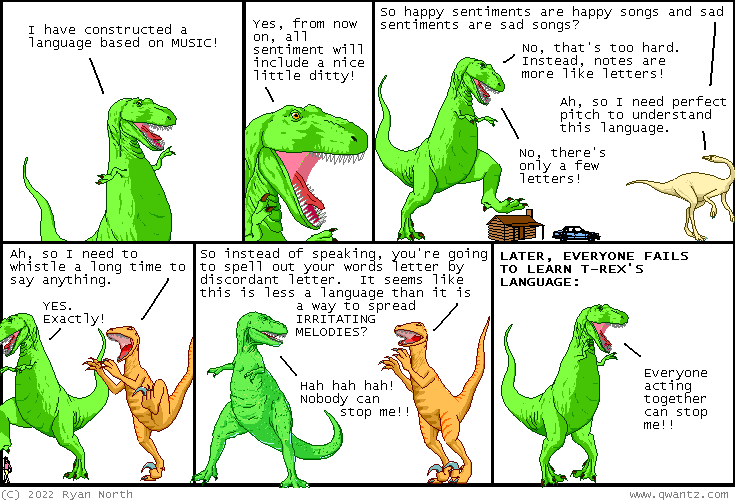Musical languages
Language Log 2022-04-17
The latest Dinosaur Comics: 
The mouseover title: "whistle morse code with dot as a D note and dash as a G flat and you're already there, laying down the sickest of beats. a truly unwell beat" What would this sound like?
Well, the text in the first panel — "I have constructed a language based on music" — turns into Morse code this way:
.. / …. .- …- . / -.-. — -. … – .-. ..- -.-. – . -.. / .- / .-.. .- -. –. ..- .- –. . / -… .- … . -.. / — -. / — ..- … .. -.-.
which sounds something like this in Ryan North's musical language (minus the whistling part, and with apologies to real Morse coders):
Your browser does not support the audio element.
which I agree is a truly unwell beat.
Meanwhile, the internets are buzzing with Binary Fungus Language, following on Adam Adamatzkey, "Language of fungi derived from their electrical spiking activity", Royal Society 4/6/2022:
Fungi exhibit oscillations of extracellular electrical potential recorded via differential electrodes inserted into a substrate colonized by mycelium or directly into sporocarps. We analysed electrical activity of ghost fungi (Omphalotus nidiformis), Enoki fungi (Flammulina velutipes), split gill fungi (Schizophyllum commune) and caterpillar fungi (Cordyceps militaris). The spiking characteristics are species specific: a spike duration varies from 1 to 21 h and an amplitude from 0.03 to 2.1 mV. We found that spikes are often clustered into trains. Assuming that spikes of electrical activity are used by fungi to communicate and process information in mycelium networks, we group spikes into words and provide a linguistic and information complexity analysis of the fungal spiking activity. We demonstrate that distributions of fungal word lengths match that of human languages. We also construct algorithmic and Liz-Zempel complexity hierarchies of fungal sentences and show that species S. commune generate the most complex sentences.
So has T Rex been scooped by Schizophyllum commune?
More on that later. For now, I'll just note that additional evidence of communicative intelligence outside the animal kingdom might be problematic for vegetarians — though of course we've known for a long time that even bacteria communicate.
(And I should add that simple random processes have long been known to generate sequences with language-like statistical properties — whether the mushroom-talk recordings are susceptible to such interpretation remains to be seen.)